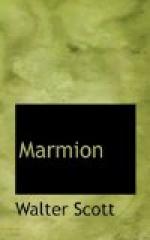line 153. Scott mentions Chalmers’s edition of Lyndsay’s works, published in 1806. More recent and very satisfactory editions are those of Dr. David Laing, (1) a library edition in three volumes, and (2) a popular edition in two. Lyndsay was born about 1490 and died about 1555. The Mount was his estate, near Cupar-Fife. ’I am uncertain,’ says Scott, ’if I abuse poetic license, by introducing Sir David Lindesay in the character of Lion-Herald, sixteen years before he obtained that office. At any rate, I am not the first who has been guilty of that anachronism; for the author of “Flodden Field” despatches Dallamount, which can mean nobody but Sir David de la Mont, to France on the message of defiance from James iv to Henry VIII. It was often an office imposed on the Lion King-at-arms, to receive foreign ambassadors; and Lindesay himself did this honour to Sir Ralph Sadler, in 1539-40. Indeed, the oath of the Lion, in its first article, bears reference to his frequent employment upon royal messages and embassies. The office of heralds, in feudal times, being held of the utmost importance, the inauguration of the Kings-at-arms, who presided over their colleges, was proportionally solemn. In fact, it was the mimicry of a royal coronation, except that the unction was made with wine instead of oil. In Scotland, a namesake and kinsman of Sir David Lindesay, inaugurated in 1502, “was crowned by King James with the ancient crown of Scotland, which was used before the Scottish Kings assumed a close Crown;” and, on occasion of the same solemnity, dined at the King’s table, wearing the crown. It is probable that the coronation of his predecessor was not less solemn. So sacred was the herald’s office, that, in 1515, Lord Drummond was by Parliament declared guilty of treason, and his lands forfeited, because he had struck, with his fist, the Lion King-at-arms, when he reproved him for his follies. Nor was he restored, but at the Lion’s earnest solicitation.’
Stanza X. line 194. ’A large ruinous castle on the banks of the Tyne, about ten miles from Edinburgh. As indicated in the text, it was built at different times, and with a very differing regard to splendour and accommodation. The oldest part of the building is a narrow keep, or tower, such as formed the mansion of a lesser Scottish baron; but so many additions have been made to it, that there is now a large courtyard, surrounded by buildings of different ages. The eastern front of the court is raised above a portico, and decorated with entablatures, bearing anchors. All the stones of this front are cut into diamond facets, the angular projections of which have an uncommonly rich appearance. The inside of this part of the building appears to have contained a gallery of great length, and uncommon elegance. Access was given to it by a magnificent stair-case, now quite destroyed. The soffits are ornamented with twining cordage and rosettes: and the whole seems to have been far




